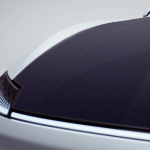With an $800-plus billion electric vehicle market looming over the horizon by 2027, the idea of charging your zero emission car on-the-go with a solar rooftop is trotting along not far behind. The key challenge is coming up with a system light enough, and efficient enough, to make the whole exercise in direct solar-powered mobility worthwhile.
Two companies that claim to have the solar EV roof all figured out are Royal DSM and Lightyear. Lightyear’s signature Lightyear One electric vehicle is set to launch next year with five square meters of built-in solar cells covering the roof and hood.
With that much juice, Lightyear estimates that its solar roof can provide an average of 70-90% of a car’s annual mileage.
If that sounds rather ambitious, it is. As for whether or not it sounds too good to be true, the two partners note that the 70-90% calculation applies to “optimized” vehicles.
The two companies have just announced a plan to bring the solar technology to other electric vehicle makers, so your mileage may vary. However, the technology behind the new solar roof does suggest a significant improvement in efficiency compared to past attempts.
That’s where DSM comes in. Among DSM’s fields is the unglamorous area of solar backsheets. A backsheet is basically there to protect the back of the solar panel from UV radiation, dust, sunlight, humidity, and other hazards.
The DSM backsheet is a horse of a different color. Here, let’s have them explain:
“DSM’s Conductive backsheet is an integral element of the solar roof – enabling all the connections of the solar cells to be put on the back of the solar panel – thus making every available centimeter on the front of the module available for capturing sunlight. The reduction in electrical (cell-to-module) losses not only delivers a 3% increase in power output; it has the added advantage of contributing to a more stylish sunroof with aesthetic appeal.”
Look Who Else Is Diving Into The Solar Roof Fray
Another solar technology improvement is evident in Toyota’s approach. Last summer the company paired up with Sharp and NEDO (the New Energy and Technology Development Organization of Japan) to test drive a electric vehicle with a solar roof.
The car deploys a new lightweight thin film solar cell introduced by Sharp a few years back, with the specific aim of supporting a broader solar-powered electric vehicle initiative under the NEDO umbrella.
Another player is Hyundai, which already jumped the solar roof gun last summer when it announced a new solar-equipped edition of the Sonata hybrid EV, so there’s that.
Last year our friends over at Interesting Engineering also surveyed electric vehicle makers for other solar roof attempts. They found a number of interesting startups in the mix, including a self-driving EV that can be programmed to drive itself into the sun for optimal charging.
Since no discussion of electric vehicles is complete without a mention of Tesla Motors, let’s note for the record that Tesla CEO and COVID-19 freedom fighter Elon Musk has not been a particularly big fan of solar panels on cars, though he is reportedly dipping a toe in through the Cybertruck window.
Gearing Up For The Electric Vehicle Revolution With Clean Electricity
Until solar panels become a standard feature on electric vehicles, there’s always the option of plugging into a charging station that sources electricity from the sun.
With that in mind let’s take a quick look at some news from General Motors.
GM has been on a solar power tear since at least 2013, when it installed a 1.8 megawatt rooftop solar array on one of its facilities in Ohio.
Last month, the company upped the solar ante with an ambitious clean power buy in partnership with Michigan utility DTE. The deal is noteworthy because it helps nudge every electric vehicle owner on the local grid in the direction of renewable energy.
In a similar solar initiative, earlier this week GM announced a green tariff deal with the Tennessee Valley Authority for 100 megawatts of solar power annually, sourced from a new solar farm under development in Mississippi by the company Origis Energy.
The juice will go to GM’s largest North American facility, Spring Hill in Tennessee, and the ripple effect will be to stimulate solar development throughout the TVA’s sprawling seven-state service territory.
Proving that it apparently can walk and chew gum at the same time, GM has been pressing forward on the solar front even while pivoting to the PPE supply area for COVID-19 response.
GM is also planning to restart its Kokomo plant on Monday. The plant shuttered on March 20 for auto making but hundreds of workers have been on site for weeks, producing medical ventilators in partnership with the company Ventec Life Systems. That has provided GM with a chance to pilot test worker safety measures, which it plans to apply across its operations.







